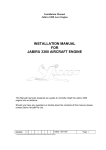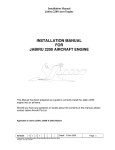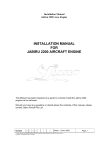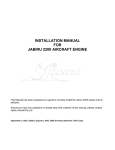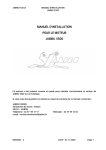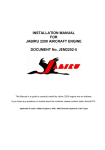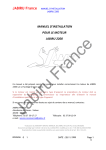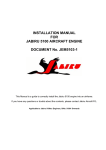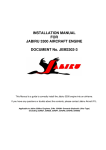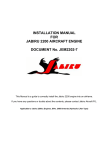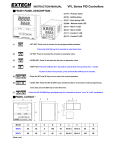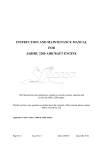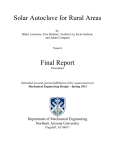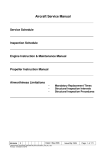Download Installation Manual 3300
Transcript
Installation Manual Jabiru 3300 Aero Engine INSTALLATION MANUAL FOR JABIRU 3300 AIRCRAFT ENGINE This Manual has been prepared as a guide to correctly install the Jabiru 3300 engine into an airframe. Should you have any questions or doubts about the contents of this manual, please contact Jabiru Aircraft Pty Ltd. REVISION 0 1 2 3 4 H:\files\engine_manuals\3300_engine_manuals\Installation Manual 3300.doc Dated : 22/08/03 Page: 1 Installation Manual Jabiru 3300 Aero Engine Table of Contents 1.0 DESCRIPTION ______________________________________________________ 4 2.0 SPECIFICATIONS ___________________________________________________ 4 3.0 DIMENSIONS _______________________________________________________ 5 4.0 DENOMINATION OF CYLINDERS_____________________________________ 5 5.0 ENGINE MOUNT ____________________________________________________ 6 6.0 CONTROLS _________________________________________________________ 8 6.1 Throttle and Choke _________________________________________________________ 8 6.2 Master Switch, Ignition Switches and Starter Button _____________________________ 8 7.0 INSTRUMENTS______________________________________________________ 8 7.1 Electronic Tachometer ______________________________________________________ 8 7.2 Oil Temperature Gauge _____________________________________________________ 8 7.3 Oil Pressure Gauge _________________________________________________________ 8 7.4 Cylinder Head Temperature Gauge ___________________________________________ 9 7.5 Exhaust Gas Temperature Gauge _____________________________________________ 9 8.0 ELECTRICAL EQUIPMENT__________________________________________ 11 8.1 Alternator ________________________________________________________________ 12 8.2 Regulator ________________________________________________________________ 12 8.3 Ignition __________________________________________________________________ 12 8.4 Starter Motor _____________________________________________________________ 13 8.5 Battery___________________________________________________________________ 13 8.6 Additional Wiring Information ______________________________________________ 13 9.0 FUEL SUPPLY SYSTEM _____________________________________________ 14 9.1 Fuel Tank ________________________________________________________________ 14 9.2 Fuel Filtration ____________________________________________________________ 14 9.3 Mechanical Fuel Pump _____________________________________________________ 14 9.4 Carburettor ______________________________________________________________ 14 9.5 Fuel Lines ________________________________________________________________ 15 10.0 AIR INTAKE SYSTEM _______________________________________________ 15 10.1 Air Filter ________________________________________________________________ 15 11.0 EXHAUST SYSTEM _________________________________________________ 15 REVISION 0 1 2 3 4 H:\files\engine_manuals\3300_engine_manuals\Installation Manual 3300.doc Dated : 22/08/03 Page: 2 Installation Manual Jabiru 3300 Aero Engine 12.0 COOLING SYSTEMS ________________________________________________ 15 13.0 PROPELLER SELECTION ___________________________________________ 16 14.0 AUXILIARY UNITS _________________________________________________ 16 Appendix A ______________________________________________________________ 16 Appendix B ______________________________________________________________ 19 LIST OF EFFECTIVE PAGES The dates of issue for original & revised pages are: Page Issue Date 1 2 3 4 5 6 7 8 9 10 11 12 13 14 15 16 17 18 19 1 1 1 1 1 1 1 1 1 1 1 1 1 1 1 1 1 1 1 09/03/99 09/03/99 09/03/99 09/03/99 09/03/99 09/03/99 09/03/99 09/03/99 09/03/99 09/03/99 09/03/99 09/03/99 09/03/99 09/03/99 09/03/99 09/03/99 09/03/99 09/03/99 09/03/99 REVISION 0 1 2 3 4 H:\files\engine_manuals\3300_engine_manuals\Installation Manual 3300.doc Dated : 22/08/03 Page: 3 Installation Manual Jabiru 3300 Aero Engine 1.0 - 4 Stroke 6 Cylinder Horizontally Opposed 1 Central Camshaft Push Rods Over Head Valves (OHV) Ram Air Cooled Wet Sump Lubrication Direct Propeller Drive Dual Transistorised Magneto Ignition Integrated AC Generator Electric Starter Mechanical Fuel Pump Naturally Aspirated – 1 Pressure Compensating Carburettor 8 Bearing Crankshaft 2.0 - - DESCRIPTION SPECIFICATIONS Displacement Bore Stroke Compression Ratio Direction of Rotation of Prop Shaft Ramp Weight : : : : 3314 cc 97.5 mm 74 mm 7.8:1 s/n 224 on is 8:1 : : Clockwise – Pilot’s view – Tractor Applications 81 kg (178 lbs) Complete including Exhaust, Carburettor, Starter Motor, Alternator & Ignition System. 25o BTDC 1–4–5–2–3–6 20 Amps : : : - Ignition Timing Firing Order DC Output Fuel Consumption @ 75% Power Fuel - Oil : - Oil Capacity Spark Plugs : : REVISION 0 1 2 : : 3 4 H:\files\engine_manuals\3300_engine_manuals\Installation Manual 3300.doc 24 l/hr (6 US gal/hr) AVGAS 100LL and AVGAS 100/130 Leaded and Unleaded Motor Gasoline above 95 Octane Ron Aero Oil W Multigrade 15W-50, or equivalent Lubricant complying with MIL-L-22851C, or Lycoming Spec. 301F, or Teledyne – Continental Spec MHF-24B 3.5 L (3.69 US Quarts) NGK D9EA – Automotive Dated : 22/08/03 Page: 4 Installation Manual Jabiru 3300 Aero Engine 3.0 DIMENSIONS 4.0 DENOMINATION OF CYLINDERS REVISION 0 1 2 3 4 H:\files\engine_manuals\3300_engine_manuals\Installation Manual 3300.doc Dated : 22/08/03 Page: 5 Installation Manual Jabiru 3300 Aero Engine Cylinder Firing Order: 1 – 4 – 5 – 2 – 3 – 6 5.0 ENGINE MOUNT The design of the engine mount must not only take into account the structural loadings but must make allowances for accessibility of components and the removal of equipment located at the rear of the engine. The engine has four engine mounting points located at the rear of the engine (refer to figure 1.0) from which the engine is to be mounted. An optional bed mount may be fitted. Figure 1.0 – Engine Mount Point Locations The correct installation is shown below in figure 2.0 REVISION 0 1 2 3 4 H:\files\engine_manuals\3300_engine_manuals\Installation Manual 3300.doc Dated : 22/08/03 Page: 6 Installation Manual Jabiru 3300 Aero Engine Figure 2.0 – Engine Mount Assembly Corrections of the engine alignment may be made using spacers under the rubber cushions. The maximum spacer thickness on any one mount is 3mm. REVISION 0 1 2 3 4 H:\files\engine_manuals\3300_engine_manuals\Installation Manual 3300.doc Dated : 22/08/03 Page: 7 Installation Manual Jabiru 3300 Aero Engine 6.0 CONTROLS This section comprises of the mechanical controls and electrical switches. 6.1 Throttle and Choke Provisions for the connection of the throttle and choke are made on the carburettor. Note: Since a pressure compensating carburettor is used there is no mixture control. 6.2 Master Switch, Ignition Switches and Starter Button The switches are connected as shown by the circuit diagram, on Page 10. 7.0 INSTRUMENTS 7.1 Electronic Tachometer The tachometer uses a pick-up mounted on the alternator mounting bracket which ‘counts’ the teeth of the flywheel ring gear. Jabiru Part No. PI10772N is the recommended tachometer. On later engines tacho picks up on 2 metal tabs attached to the inside of the flywheel. Pick up is of induction sender type. Tachometer Wiring 3 Tachometer Negative (3) to Earth 4 Tachometer Positive (4) to Instrument 8 Tachometer to Red Wire tachometer pick-up 7 Tachometer to Black Wire tachometer pick-up 7.2 Oil Temperature Gauge The Oil Temperature Gauge uses an electric probe mounted in the base of the sump. Jabiru Part No. PI10752N is recommended. Oil Temperature Wiring Black Oil Temperature Gauge Negative to Earth Red Oil Temperature Gauge Positive to Instrument White Oil Temperature Gauge Sensor (S) to Oil Temperature Sensor (Lower Left Eng Sump) 7.3 Oil Pressure Gauge An electric oil pressure sender is fitted to the engine for an Oil Pressure Gauge. Jabiru Part No. PI10762N is the recommended gauge. Oil Pressure Wiring Black Oil Pressure Gauge Negative to Earth Red Oil Pressure Gauge Positive to Instrument White Oil Pressure Gauge Sensor (S) to Oil Pressure Sensor (Fwd Top Eng) REVISION 0 1 2 3 4 H:\files\engine_manuals\3300_engine_manuals\Installation Manual 3300.doc Dated : 22/08/03 Page: 8 Installation Manual Jabiru 3300 Aero Engine 7.4 Cylinder Head Temperature Gauge The Cylinder Head Temperature Gauge uses a thermocouple. An audit must be done to establish the hottest cylinder and the thermocouple probe should be fitted under the exhaust spark plug on that cylinder. Jabiru Part No. PI10732N is the recommended gauge. Cylinder Head Temperature Wiring Loom and sensor is supplied with the instrument. These must be installed as per directions. If cable is too long it must be looped as many times as necessary and strapped behind the instrument panel. Temperature of cold junction for best results should be around 50º C. Ensure cold junction is furthest from the thermo couple probe as possible. DO NOT CUT TO LENGTH Ensure that wire is not chaffing on the fibreglass air duct or cooing fins. No power connection is required. 7.5 Exhaust Gas Temperature Gauge An optional Exhaust Gas Temperature Gauge can be fitted. The probe should be positioned 100mm from the port flange on the exhaust pipe of a convenient cylinder. Jabiru Part No. PI0325N is the recommended gauge. SCAT HOSE Remove at each 50 hourly inspection one end of each scat hose. Inspect for holes, leaks and condition of helical wound wire former. Replace if any signs of corrosion is evident. REVISION 0 1 2 3 4 H:\files\engine_manuals\3300_engine_manuals\Installation Manual 3300.doc Dated : 22/08/03 Page: 9 Installation Manual Jabiru 3300 Aero Engine REVISION 0 1 2 3 4 H:\files\engine_manuals\3300_engine_manuals\Installation Manual 3300.doc Dated : 22/08/03 Page: 10 Installation Manual Jabiru 3300 Aero Engine WARNING PROBLEM – Three Phase stator and regulator burning out. WARNING – Please note brown positive wire on regulator must only carry a current when the engine is running. The brown wire must be isolated when the engine is not in use. Wiring through master switch is O.K. if the engine is started straight away. Problems will occur when engine is not started straight away e.g. someone carrying out ground testing of radios and electrical equipment. If this is carried out the brown wire will have to be isolated or the regulator and stator will burn out. Note: Three phase units used on s/n 01 – 163. Single Phase used from s/n 164 onwards. REVISION 0 1 2 3 4 H:\files\engine_manuals\3300_engine_manuals\Installation Manual 3300.doc Dated : 22/08/03 Page: 11 Installation Manual Jabiru 3300 Aero Engine 8.0 ELECTRICAL EQUIPMENT 8.1 Alternator The alternator fitted to the early Jabiru 3300 engines is a three phase, permanently excited with a regulator. The rotor is mounted on the flywheel with the stator mounted on the alternator mount plate at the back of the engine. The alternator mount plate is also the mount for the ignition coils and the vacuum pump. Later engines use a single phase alternator. Specifications Power (Max): 200W Continuous Note: The electrical system is Negative Earth. 8.2 Regulator The regulator has been selected to match the voltage and current of the integral alternator. Only Jabiru Part No. PI12609N should be used. (The regulator output voltage is 14 volts + 0.8 volt.) Single phase alternators use regulator part no: PI10652N. Recommended wiring of regulator is positive and negative directly to battery. A suitable fuse in series would be a recommendation. 8.3 Ignition The ignition unit has dual breakerless transistorised ignition with the magnets mounted on the flywheel and the coils mounted on the alternator mount plate. The current from the coils flows to the distributor from where it is distributed to the spark plugs. (See also Regulator Wiring at Page 12.) The ignition is turned off by grounding the coils via the ignition switches. The ignition is timed to 25o BTDC The temperature limit for the ignition coils is 70oC. This should be checked by the installer. It is recommended to fit a small pipe around ½inch (12mm dia) from the top rear of the air duct and routed down to the coil to assist in cooling. Ignition coils should be mounted on insulating washers. Transistorised Ignition 1 Wiring No. 1 Switch – Upper to Left Transistorised Ignition No. 1 Switch – Lower to Earth REVISION 0 1 2 3 4 H:\files\engine_manuals\3300_engine_manuals\Installation Manual 3300.doc Dated : 22/08/03 Page: 12 Installation Manual Jabiru 3300 Aero Engine Switch Open for Ignition ON, closed for Ignition OFF. Transistorised Ignition 2 Wiring No. 2 Switch – Upper to Right Transistorised Ignition No. 2 Switch – Lower to Earth Switch Open for Ignition ON, closed for Ignition OFF. 8.4 Starter Motor The starter is mounted on the top of the engine and drives the ring gear on the flywheel. The motor is activated by engaging the starter button (the master switch has to be ON) which trips the solenoid, hence current flows from the battery to the motor. The cable from Battery to starter should be minimum 16mm2 copper. Starter Wiring Starter Button Switch (lower) to Main Bus Starter Button Switch (upper) to Start Solenoid (through Grommet) 8.5 Battery The battery should be of a light weight, 12V, 20 Ah type able to accept a charging voltage up to 14 V (+ 0.8V) and a 25 AMP Input. 8.6 Additional Wiring Information Engine Hourmeter Wiring Red Hourmeter Positive to Positive Black Oil Pressure Switch to Engine Sump Bolt Black Hourmeter to Oil Pressure Switch (Fwd Eng Left) Earth Wiring Black Black Battery Earth Negative to Firewall Earth (Engine Bay) Battery Earth Negative to Earth Bus Master Wiring Red Red Red Red Starter Solenoid to Main Fuse Main Fuse to Master Switch (Lower) Master Switch (Upper) to Main Bus Main Bus to Red on Regulator Fuel Pump Wiring Red Main Bus to Fuel Pump Fuse Red Fuel Pump Fuse to Fuel Pump Switch (Lower) REVISION 0 1 2 3 4 H:\files\engine_manuals\3300_engine_manuals\Installation Manual 3300.doc Dated : 22/08/03 Page: 13 Installation Manual Jabiru 3300 Aero Engine Red Black Fuel Pump Switch (Upper) to fuel Pump (Red Wire) Fuel Pump (Black Wire) to Earth Bus Regulator Red Regulator Wire to Battery Brown Regulator Wire to Positive (only when ignition is on) Black Regulator Wire to Earth 3 Yellow Regulator Wires to any 3 White Alternator Wires Single Phase – 2 alternator wires to pale blue, red and yellow to positive bus and black to negative bus. Battery Cables Black Starter Motor Mount (Engine Rear) to Battery Negative Red Battery Positive to Starter Solenoid Red Starter Solenoid (Switched) to Starter Motor (Part of) 9.0 FUEL SUPPLY SYSTEM 9.1 Fuel Tank The fuel tank must be fitted with an outlet strainer of between 8 and 16 mesh per inch, with a minimum total mesh area of 5 cm2. 9.2 Fuel Filtration A Fuel filter capable of preventing the passage of particles larger than 0.1mm (100um) must be installed between the fuel tank outlet and the fuel pump. The filter must be present in the system for the fuel flow test. The size of the filter should give consideration to allow adequate flow with a used filter. A Ryco Z15 or similar filter has been used successfully. 9.3 Mechanical Fuel Pump The mechanical fuel pump is mounted on the engine crankcase and is camshaft driven. It is designed to supply fuel at the pressure described in the following paragraph. To prevent fuel vaporization in the fuel pump a small amount of air directed onto the pump is advised, especially when using mogas. Electric Boost Pump must also be capable of no more than 3lb pressure. 9.4 Carburettor A Bing constant depression type is used. This carburettor has a minimum delivery pressure of 5 kPa (0.75 Psi) and a maximum pressure of 20 kPa (3 psi). To confirm that the fuel system is capable of delivering this pressure a fuel flow test must be performed. A method for performing a fuel flow test is available from Jabiru if required. A drip deflector to deflect overflowing fuel from the exhaust system is supplied as standard equipment on the engine. REVISION 0 1 2 3 4 H:\files\engine_manuals\3300_engine_manuals\Installation Manual 3300.doc Dated : 22/08/03 Page: 14 Installation Manual Jabiru 3300 Aero Engine Because the engine is dyno run some adjustment of the 7mm idle set screw may have to be made. A hot idle of around 700 RPM is desirable. Earth strap from carby to crankcase is recommended. 9.5 Fuel Lines Fuel lines are nominally 6mm bore. All hoses forward of the firewall require fire resistant sheathing and those between moving sections such as between engine and firewall should be flexible. Hoses must be changed every two years. 10.0 AIR INTAKE SYSTEM 10.1 Air Filter The air filter must be of a type so as to not cause positive RAM induction pressure. The filter must be capable of supplying 250 kg/hr (550 pph) of air The filter may have to be changed at regular intervals if the engine is to be used in a dusty environment. Air flow should be as direct as possible, no tight bends and air taken from outside the cowl. 11.0 EXHAUST SYSTEM An exhaust system is provided with the engine. Both Pusher and Tractor systems are available. Muffler Volume – Capacity 5 litres Back pressure at Takeoff Performance – Max 0.2 bar (2.9 psi) – readings taken 70mm from muffler flange connections. Exhaust Gas Temperature (EGT) - Nominal 650o – 750o (1202oF – 1382oF) measured 100mm from the exhaust manifold flange. 12.0 COOLING SYSTEMS The engine should be installed using RAMAIR ducts provided with the engine. Cylinder and cylinder head cooling is achieved by ducting air over the cylinders and heads. The static air pressure inside the cooling ducts must not be lower than 4.3cm (1.7”) water gauge at 1.3 times the stall speed. REVISION 0 1 2 3 4 H:\files\engine_manuals\3300_engine_manuals\Installation Manual 3300.doc Dated : 22/08/03 Page: 15 Installation Manual Jabiru 3300 Aero Engine An oil cooler should be installed and sized to achieve oil temperatures within the engine limits. Hoses should be nominally 8mm (5/16”) bore. Hoses must be changed every 2 years. Later coolers accept 3/8” diameter hoses. The limits in the Specification Sheet, contained in Appendix B, must be strictly adhered to. Warranty will not be paid on engine damage attributed to overheating of cylinders or oil. The cooling ducts provided are only a starting point in establishing effective engine cooling. The ducts may require to be increased in size and additional baffles provided to achieve the specified maximum cylinder head temperature of 175 oC. Air ducts should have an air bleed hole of around 25mm in dia cut into the inside top of each air duct and facing the crankcase. This provides air over the crankcase region. The air ducts may need increasing in size and additional baffles depending on installation. See head temperature range page 20. 13.0 PROPELLER SELECTION The hub of the propeller must be drilled with holes to match the flange. The propeller must be carefully selected to match the airframe and the engine. Propellers up to 1778mm (70”) in diameter and between 762mm (30”) and 1397mm (55”) in pitch may be used. The propeller flange is drilled with 6 5/8” holes at 4 3/8” PCD. Movements of inertia up to 0.3 kgm2 Applications outside this range should be referred to Jabiru. 14.0 AUXILIARY UNITS Vacuum Pump For the installation of an artificial horizon and/or a direction gyro a vacuum pump is necessary. A Tempest 212CW (or equivalent) vacuum pump can be fitted to the alternator mounting plate and directly coupled to the crankshaft. The drive pad is dry. The pad and spline are SAE Standard. NOTE: Unless operating in cool environments oil coolers are mandatory. The adapter is fitted under the oil filter and can be plumbed either way to the cooler. Continuous operation with oil REVISION 0 1 2 3 4 H:\files\engine_manuals\3300_engine_manuals\Installation Manual 3300.doc Dated : 22/08/03 Page: 16 Installation Manual Jabiru 3300 Aero Engine temperatures between 70 degrees and 90 degrees Celsius is desirable. REVISION 0 1 2 3 4 H:\files\engine_manuals\3300_engine_manuals\Installation Manual 3300.doc Dated : 22/08/03 Page: 17 Installation Manual Jabiru 3300 Aero Engine Appendix A REVISION 0 1 2 3 4 H:\files\engine_manuals\3300_engine_manuals\Installation Manual 3300.doc Dated : 22/08/03 Page: 18 Installation Manual Jabiru 3300 Aero Engine Appendix B SPECIFICATION SHEET Models: Jabiru 3300 1. MANUFACTURER Jabiru Aircraft Pty Ltd P.O. Box 5186 Bundaberg West Queensland 4670 2. ENGINE PARTICULARS 3.1 Description Six cylinder, horizontally opposed, four stroke engine, direct propeller drive, air cooled, wet sump, pressure lubricated, dual magneto high voltage transistorised contactless ignition, 1 x constant-pressure carburettor, electric starter, generator, mechanical fuel pump. Vacuum pump optional. 3.2 3.3 3.4 3.5 3.7 Displacement Bore Stroke Compression Ratio Net Dry Weight 3.8 Propeller Rotation Direction 3314 cm3 97.5 mm 74 mm 7.8 : 1 s/n 224 on is 8:1 81 kg (includes exhaust, starter, flywheel alternator) Clockwise (viewed from rear) 3. ENGINE PERFORMANCE Static sea level ratings under the following conditions:(a) International Standard Atmospheric conditions at sea level. (b) Aircraft service equipment drives unloaded. (Vacuum Pump not fitted) (c) Full rich fuel/air mixture. (d) Maximum cylinder head temperature. (e) Standard Jabiru air filter and cold air. (f) Standard exhaust muffler. REVISION 0 1 2 3 4 H:\files\engine_manuals\3300_engine_manuals\Installation Manual 3300.doc Dated : 22/08/03 Page: 19 Installation Manual Jabiru 3300 Aero Engine 4.1 Engine Ratings Maximum 120 HP / 3300 RPM ISO STD Conditions 5. OPERATING LIMITATIONS 5.1 RPM Maximum : Recommended Cruise : 3300 RPM 2750 RPM 5.2 Engine Cooling Cylinder Head Temperature Takeoff Continuous 175oC Maximum 150oC Maximum 5.3 Fuel 5.3.1 Specifications Avgas 100LL & Avgas 100/130 Leaded and Unleaded Motor Gasoline above 95 Octane Ron 5.3.2 Pressure to Carburettor (above ambient) (a) Maximum (b) Minimum 20 kPa 5 kPa WARNING – When using auto fuels, ensure all components of the fuel delivery system are cooled to prevent fuel vaporization. 5.4 Oil 5.4.1 REVISION Specification Aero Oil W Multigrade 15W-50, or equivalent Lubricant complying with MIL-L-22851C, or Lycoming Spec. 301F, or Teledyne - Continental Spec MHF-24B 0 H:\files\engine_manuals\3300_engine_manuals\Installation Manual 3300.doc Dated : 09/11/00 Page: 20 Installation Manual Jabiru 3300 Aero Engine 5.4.2 Inlet Temperature Minimum for Operation Maximum Continuous 5.4.3 Pressure Normal Operations Min Max Idle Min Starting & Warm Up Max 15oC 118oC 80oC – 100oC 220 kPa 525 kPa 80 kPa 525 kPa 6. TYPES OF PROPELLER Fixed pitch wooden propellers. Maximum propeller diameter 1778mm (70"). 7. EQUIPMENT (a) The following equipment is included in the engine approval:Carburettor: 1 x Bing constant Pressure carburettor Type 94/40 Main Jet 2.80, Needle Jet 280 (278) Fuel Pump: Mechanical, Jabiru part No: PG10332N Ignition System: Jabiru dual magneto, high voltage transistorised, contactless. Part No: PI10522N Spark Plugs: NGK D9EA Alternator: Integrated Jabiru, permanent magnet three phase alternator or single phase type. Starter: Jabiru 12V/1.0 kW, engagement via reduction gear and freewheel. Bosch type part no: 4776093. (b) The following optional equipment may be driven by or fitted to the engine subject to the type number being included in the approved Jabiru Aircraft Pty Ltd engine specification:Vacuum Pump REVISION 0 H:\files\engine_manuals\3300_engine_manuals\Installation Manual 3300.doc Dated : 09/11/00 Page: 21 Installation Manual Jabiru 3300 Aero Engine Appendix C Tips on Jabiru Engine Installations 1. Prop Standard of 2800 – 2900 RPM at take off and 3200 in the air straight and level. This will vary from aircraft and prop type. Variation from these with prop lead will affect tuning. Carby tuning must not be altered other than with advice from Jabiru Aircraft. 2. Tacho Accuracy is obvious. Check with another instrument 3. Cooling Cowls should have adequate entry and exit areas. Care taken not to flood the cowl area with oil cooler air. Air ducts as supplied are starting points. 4. Air Induction Entry from outside the cowl. All scat hoses should have only slight bends, no sharp edges on exiting air. Adequate filter size. 5. Carby Bowl vent to filtered side of air box. Two sense holes on rear of venture should not be obscured. Correct idle hot. Ensure throttle and choke movement is correct. 6. Fuel Pump Ensure boost pump is not capable of more than 3lb pressure. 7. Oil Correct type used for first 25 – 30 hours. Expel inhibiting oil from cylinders and pressure up before first start. Oil coolers are mandatory. Do not overfill the engine. 8. Fuel Only Avgas 100LL or MOGAS above 95 Octane to be used. Fuel filter in line. Full tank vented. 9. Oil Overflow Use of small collector for engine oil venting. 10. Heads/Valves (See section on early operation 4.7) Valve clearance and head tension done at regular intervals. 11. No Oil or fuel additives should be used 12. Temperature Refer to correct temperature operation of the engine 13. Connections 14. REVISION G on oil pressure sender to gauge W is for warning light Regulator as per instructions. Oil temp CHT EGT Fuel hoses/oil hoses with heat shield Correct throttle/choke movement Carby heat arrangement working Correct scat hoses and directions Sump vent pipe to collection bottle Poor connections and air gaps to ducts/cooler etc give second rate cooling 0 H:\files\engine_manuals\3300_engine_manuals\Installation Manual 3300.doc Dated : 09/11/00 Page: 21 Installation Manual Jabiru 3300 Aero Engine 15. Check for contact of engine to cowl. 16. Damage caused by overheating due to poor installation techniques would not be covered under warranty. Operation of the engine on non approved oils and fuel will likewise not be covered. 17. Overall performance of engine and airframe depends on correct installation and prop match. REVISION 0 H:\files\engine_manuals\3300_engine_manuals\Installation Manual 3300.doc Dated : 09/11/00 Page: 21 Installation Manual Jabiru 3300 Aero Engine Typical Installation- 4/6 Cylinder Jabiru Engine Reference: Drawing Photos Parts Required: Materials Required: Please note: Prop Selection should aim to obtain 2800-2900 @ T/O & around 3200RPM full power Straight & Level. Operation of the engine out side these Values may affect engine tuning. • All Glass joins must have smoothed interiors. • Strongly recommend engines use air mixer box, adequate filter size, carby heat arrangement. • Note: Slope of air scat hose to carby & glass Joiner. • Important that scat hose not bunched up on carby. (no tight bends in scatt hose). Use a glass joiner to prevent this and change direction. Upper sensor holes on carby intake must not be covered by scat hose. • Air Inlet from outside cowl Keep cold junction of CHT Sender away from heads Air Induction Air Ducts attached by front/back rocker cover cap screws Oil Cooler mounted on rubber grommets Prop Torque on wooden Jabiru prop 6 ½ -7Ft LB (9NM) REVISION 0 1 2 3 4 H:\files\engine_manuals\3300_engine_manuals\Installation Manual 3300.doc Print Date: 11/10/03 12:29 PM Dated : 22 August 2003 Page: 1 Installation Manual Jabiru 3300 Aero Engine • REVISION 0 1 Air Pipes to bleed air to both coils on each air duct. 2 3 4 H:\files\engine_manuals\3300_engine_manuals\Installation Manual 3300.doc Print Date: 11/10/03 12:29 PM Dated : 22 August 2003 Page: 2 Installation Manual Jabiru 3300 Aero Engine Connect Engine Reference: Photo Parts Required: Various – Refer to Packing List for this Section Male Rubber Engine mount Female Rubber Engine mount Washer- Engine mount Spacer Washer- Engine mount Air duct Spring Guide Bush Prop Spring Mounting Bracket, Rivet & Washer Lock wireRam Air Cooling Ducts Belleville Washer Exhaust Spring Engine Accessory Pack Bolts Required: Engine – Engine Mount :- AN4-31a x 4 Procedure: 1. Attach Female Rubbers Engine mount to both engine attach point on the Top Only. 2. Attach Male Rubber Engine mount to lower engine mount pins. REVISION 0 1 2 3 4 H:\files\engine_manuals\3300_engine_manuals\Installation Manual 3300.doc Print Date: 11/10/03 12:29 PM Dated : 22 August 2003 Page: 3 Installation Manual Jabiru 3300 Aero Engine 3. With the Back of the Aircraft Washer- Engine Supported & the mount wheels chocked, lift the engine onto Female Rubber the engine mount. Engine mount 4. Attaching the lower engine mount points first by tilting the front of the engine Heat Proof Nut down. Continue Engine Backing Plate raising the engine & align the top Male Rubber Engine mount engine mount pins. 5. Insert the Male Photo:Top of Engine attach mount points Rubber engine mount onto TOP engine mount spigots followed by the Washer- Engine mount Spacer, Washer- Engine mount, ¼” washer & Heat Proof nut. Refer to drawing. 6. Compress Rubbers by using a long deep reach socket inside in pin Engine mount & a GClamp with the swivel take off the Ball. See Photo. REVISION 0 1 2 3 4 H:\files\engine_manuals\3300_engine_manuals\Installation Manual 3300.doc Print Date: 11/10/03 12:29 PM Dated : 22 August 2003 Page: 4 Installation Manual Jabiru 3300 Aero Engine Top Engine mount Rubber Bottom Engine mount Rubber 7. Repeat same procedure for lower engine mount rubbers except attach the Engine mount rubber male first. Refer to Drawing. 8. Tighten Nut until firm. (Engine mount Washer will compress until it touches Pin Engine mount.) REVISION 0 1 2 3 4 H:\files\engine_manuals\3300_engine_manuals\Installation Manual 3300.doc Print Date: 11/10/03 12:29 PM Dated : 22 August 2003 Page: 5 O M N O A L P L E Page: 1 L Dated : 22 August 2003 I 4 C 3 A 2 B 1 L 0 E REVISION H:\files\engine_manuals\3300_engine_manuals\Installation Manual 3300.doc Print Date: 11/10/03 12:29 PM B U P A C P I P L E P R P A E O N W G I E N R E E M N O G U I N N T E C Installation Manual Jabiru 3300 Aero Engine Installation Manual Jabiru 3300 Aero Engine Fuel Line Connected From Bulk head to Fuel Pump. 9. Connect the fuel line to fuel pump. Refer to photo). Make sure the fireproof Fuel Line from Fuel Pump to Carby Fuel Pump Breather line to be vented overboard. sleeve is in place. 10. Make sure the Fuel Line from fuel pump to the carburettor in connected. 11. Ensure that the fuel overflow line is in place, refer to photo, and secured to vent overboard. REVISION 0 1 2 3 4 H:\files\engine_manuals\3300_engine_manuals\Installation Manual 3300.doc Print Date: 11/10/03 12:29 PM Dated : 22 August 2003 Page: 2 Installation Manual Jabiru 3300 Aero Engine 12. Fit the oil over flow bottle to the firewall by drilling and Riveting oil bottle holder in place using 73as 6-6 rivets. Refer to photo 13. Connect the oil breather line. Ensure that the oil overflow line is in place and vents overboard. 14. Fit Scat hoses - NACA duct to Air Inlet Housing Assembly. - Hot Air Muff to Carby Heat Inlet Oil Breather Lines Oil Bottle Oil Bottle REVISION 0 1 2 3 4 H:\files\engine_manuals\3300_engine_manuals\Installation Manual 3300.doc Print Date: 11/10/03 12:29 PM Dated : 22 August 2003 Page: 3 Installation Manual Jabiru 3300 Aero Engine - Air Inlet Housing Assembly to the Carburetor. (refer to photo ) Main Air intake to hotair mixer box. Scat hose from hot-air mixer box to heat muff onto exhaust. REVISION 0 1 2 3 4 H:\files\engine_manuals\3300_engine_manuals\Installation Manual 3300.doc Print Date: 11/10/03 12:29 PM Dated : 22 August 2003 Page: 4 Installation Manual Jabiru 3300 Aero Engine 15. Fit Carburetor cable to Carby making sure you use 2 x 5/16” washers on pin to align cable & a split pin on opposite side. Carby End Throttle Leaver End Typical Throttle & Choke REVISION 0 1 2 3 4 H:\files\engine_manuals\3300_engine_manuals\Installation Manual 3300.doc Print Date: 11/10/03 12:29 PM Dated : 22 August 2003 Page: 5 Installation Manual Jabiru 3300 Aero Engine Fit Engine Sensors Reference: Photo Parts Required: as detailed Materials Required: Procedure: Cylinder Head Temperature Sensor The cylinder head temperature sensor used in Jabiru aircraft is a J-type thermocouple located under the rear spark plug of No: 6 cylinder. The VDO 310 980 Cylinder Head Temperature Gauge Kit is installed as standard equipment in the Jabiru Aircraft. Photo– Position of oil temperature sensor, oil pressure sensor and oil pressure switch Oil Temperature Sensor The Oil Temperature Sensor used is a VDO 320 028 which is located in the bottom of the sump as shown in photo. REVISION 0 1 2 3 4 H:\files\engine_manuals\3300_engine_manuals\Installation Manual 3300.doc Print Date: 11/10/03 12:29 PM Dated : 22 August 2003 Page: 6 Installation Manual Jabiru 3300 Aero Engine Oil Pressure Sensor The oil pressure sensor is located at the base of the oil filter and this can be seen in photo. The sensor used is VDO 360 001 Oil Pressure sender unit. Connect wire to “G” terminal. The “WK” terminal is not used. Exhaust Gas Temperature Probe The exhaust gas probe used on Jabiru’s is a VDO 310 306 Pyrometer which is supplied as a complete kit. The probe is mounted in an exhaust pipe and as such the mount must be welded on, (this fitting is not standard) and this is best done at the time of order although the exhaust pipe may be returned and the fitting added it may take a couple of weeks before the pipe is returned to you. Magnetic Pick-up Sensor (Tachometer) REVISION 0 1 2 3 4 H:\files\engine_manuals\3300_engine_manuals\Installation Manual 3300.doc Print Date: 11/10/03 12:29 PM Dated : 22 August 2003 Page: 7 Installation Manual Jabiru 3300 Aero Engine The sensor used is a 6.35 x 22 mm analogue magnetic pick-up and is fitted to a bracket on the alternator housing as shown in photo in the engine electrical section. Tacho sender location REVISION 0 1 2 3 4 H:\files\engine_manuals\3300_engine_manuals\Installation Manual 3300.doc Print Date: 11/10/03 12:29 PM Dated : 22 August 2003 Page: 8




































